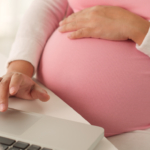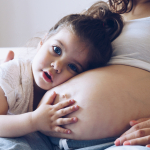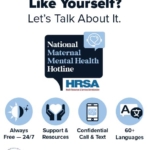Body image dissatisfaction is not an uncommon issue among women and is a significant risk factor for eating disorders. It is imperative to address — and ideally prevent — eating disorders, as they have the highest mortality rate of any psychiatric condition and can result in substantial disability (Arcelus et al., 2011). Over a third of pregnant women experience body image dissatisfaction (Roomruangwong et al., 2017), and research indicates that body image dissatisfaction generally increases during the postpartum period (Clark et al., 2009), particularly among women with a history of an eating disorder (Makino et al., 2020). Pregnancy, and the related associated changes (e.g., weight and shape) can trigger eating disorder relapse among women with histories of an eating disorder (Kouba et al., 2005).
Furthermore, women with body image dissatisfaction during pregnancy or postpartum are four times more likely to develop depression compared to mothers who are satisfied with their body image (Riquin et al., 2019). Current or past history of eating disorders have been associated with increased depression and anxiety, both during and after pregnancy, compared to women without a history of an eating disorder (Easter et al., 2015). Taken together, it is clear that current or past experience with an eating disorder and/or body image dissatisfaction present complex mental health challenges for women during the perinatal period.
Research has also identified an increased risk of disordered eating symptoms in the perinatal period even among women without an eating disorder diagnosis, yet gaps exist in our knowledge pertaining to the association between psychosocial risk factors and disordered eating in this population. Researchers in Australia (Baskin et al., 2021) recently conducted a prospective longitudinal study across pregnancy and the postpartum amongst a sample of women without a history of a diagnosed eating disorder (n=249) in order to examine:
- The change in disordered eating symptoms during pregnancy and the postpartum period,
- The psychosocial factors (i.e., attitudes to pregnancy, attitudes to mother-hood, self-compassion, relationship satisfaction and social support) during pregnancy, that predict the change in disordered eating during pregnancy and the postpartum period, and
- Whether pre-pregnancy BMI and pregnancy mental health factors (depressive or anxiety symptoms) moderate the relationships between psychosocial factors and changes in disordered eating during pregnancy and the postpartum period.
In brief, Baskin and colleagues (2021) found a significant decrease in disordered eating symptoms across pregnancy but an increase in disordered eating from pregnancy into the postpartum period. The authors conclude that for women without a diagnosis of an eating disorder, pregnancy may be a period of decreased risk of disordered eating, whereas the postpartum period presents as a more consistent period of increased risk for disordered eating. Findings suggested that more negative attitudes towards the pregnancy (including poor identification with the pregnancy, poor pregnancy body image, or worries about impending motherhood) may be a risk factor for experiencing an increased pressure to diet and restrain eating during the postpartum period. On the other hand, self-compassion and increased social support may provide some protection in mitigating the risk for eating disorders.
Of note, a higher pre-pregnancy body mass index (BMI) moderated the associations between low self-compassion and dietary restraint in pregnancy, as well as the association between maladaptive attitudes to motherhood and dietary restraint in the postpartum. The authors suggest that women with higher pre-pregnancy BMI may be more prone to self-criticism and negative expectations of motherhood, including pressure or judgment from others, and may use restraint to manage distress around pregnancy weight gain.
This brings us to an important and somewhat complicated issue; both being overweight, as well as dietary restraint and body image dissatisfaction which some women may experience when overweight, can be problematic during the perinatal period. We know that obesity (BMI > 30) is associated with adverse maternal and neonatal outcomes (see our blog), as well as an increased risk for postpartum depression (see our blog). As Baskins et al (2021) conclude, more research is needed to explore the complicated relationships among BMI, body image, and dietary restraint in order to develop interventions addressing these issues as appropriate for a given woman in the perinatal period. Interventions are needed to improve body image satisfaction and to prevent disordered eating behaviors, as well as to promote healthy weight, in the perinatal period.
We have started to conduct our own research on these topics at the CWMH. If you are pregnant or within 1 year postpartum, you can contribute to our understanding of eating behaviors and body image concerns among perinatal women, and you can provide suggestions for the development of interventions to address these issues. Please click on this link if you would like to complete this 20-minute survey – your participation would be greatly appreciated.
Rachel Vanderkruik, PhD, MSc
References:
Arcelus, J., Mitchell, A. J., Wales, J., & Nielsen, S. (2011). Mortality rates in patients with anorexia nervosa and other eating disorders. A meta-analysis of 36 studies. Arch Gen Psychiatry, 68(7), 724-731.
Baskin R, Meyer D, Galligan R. Predicting the change in perinatal disordered eating symptoms: An examination of psychosocial factors. Body Image. 2021 Mar 3;37:162-171.
Clark, A., Skouteris, H., Wertheim, E., Paxton, S., & Milgrom, J. (2009). The Relationship between Depression and Body Dissatisfaction across Pregnancy and the Postpartum A Prospective Study. Journal of health psychology. 14. 27-35. 10.
Easter, A., Solmi, F., Bye, A., Taborelli, E., Corfield, F., & Schmidt, U., et al. (2015). Antenatal and postnatal psychopathology among women with current and past eating disorders: Longitudinal patterns. European Eating Disorders Review,23(1), 19–27.
Makino M, Yasushi M, Tsutsui S. The risk of eating disorder relapse during pregnancy and after delivery and postpartum depression among women recovered from eating disorders. BMC Pregnancy Childbirth. 2020;20(1):323.
Rallis, S., Skouteris, H., Wertheim, E. H., & Paxton, S. J. (2007). Predictors of body image during the first year postpartum: A prospective study. Women & Health,45(1), 87–104.
Riquin, E., Lamas, C., Nicolas, I., Dugre Lebigre, C., Curt, F., Cohen, H., Legendre, G., Corcos, M., Godart, N. (2019). A key for perinatal depression early diagnosis: The body dissatisfaction. Journal of Affective Disorders. 15(245), 340-347.
Roomruangwong C, Kanchanatawan B, Sirivichayakul S, & Maes M. (2017). High incidence of body image dissatisfaction in pregnancy and the postnatal period: Associations with depression, anxiety, body mass index and weight gain during pregnancy. Sex Reprod Health,13:103-109.








Leave A Comment